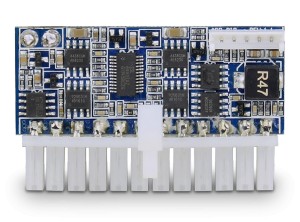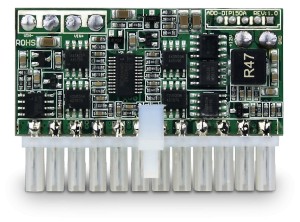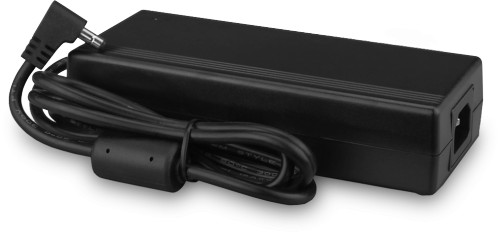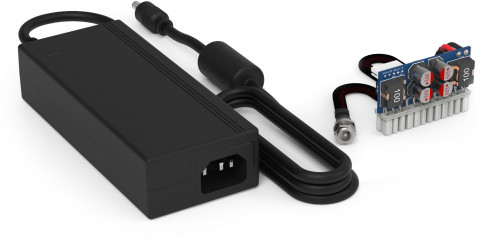Streacom nano Power Supplies
The Streacom nano power supplies are 100% silent fanless DC-DC solution. No fans, no noise, just power for small and silent PCs.
Features
- Very small, can built into ultra-compact PC enclosures and slim server enclosures
- Fits any motherboard equipped with 24pin ATX connector
- 100% silent, fanless, no moving parts
- Highly efficient design, does not produce a lot of heat
- Ideal for low wattage processors
Designed to provide silent ATX power in impossibly small spaces, the Streacom nanoPSUs are designed to fit perfectly into all Streacom cases but can also be used as a silent PSU solution for any case.
Here is our recommendation regarding which PSU to choose. If the system contains a motherboard, CPU (65W max), a SSD/HDD and an optical drive (or another SSD/HDD) then the 120W version would be more than adequate. If the system has more than one SSD/HDD and an optical drive then it is wiser to opt for the 160W version. Whichever one you choose these are the best power supplies currently available able to power a low wattage system in a tiny space.
We would only recommend the 90W version when a CPU with a TDP of 35W or lower is used along with a single storage drive.
| Specifications | 160W nanoPSU | 120W nanoPSU |
|---|---|---|
| Max Power Output | 160W | 120W |
| Form Factor | NANO | NANO |
| Input Power | 12V DC, 12.5A | 12V DC, 10A |
| Output Connectors | 1 x 24PIN ATX, 2 x SATA, 1 x Molex, 1 x 4PIN CPU | 1 x 24PIN ATX, 2 x SATA, 1 x Molex, 1 x 4PIN CPU |
| Input Power Cable Length | 400mm | 400mm |
| PCB Dimensions (WxHxD) | 54 x 26 x 18mm | 54 x 24 x 18mm |
| Input Power Range | 110-264V AC | 110-240V AC |
| Power Characteristics | <0.35W No Load, <180mV Ripple, 87% + Efficiency, Active PFC >9 | <0.5W No Load, <120mV Ripple, 87% + Efficiency, Active PFC >9 |
| AC Input Connector | C13 IEC | C13 IEC |
| Output Connector | 5.5×2.5mm DC Jack DC Cable Length: 1.2M | 5.5×2.5mm DC Jack DC Cable Length: 1.2M |
| External Dimensions (LxWxH) | 168 x 71 x 38mm | 168 x 71 x 38mm |
| Safety Certification | CE, FCC, UL, TUV, CCC | CE, FCC, UL, TUV, CCC |
| Cooling | Fanless | Fanless |
| Noise Level (50% load) | 0 dBA | 0 dBA |
| Noise Level (max) | 0 dBA | 0 dBA |
| Modular | Wired | Wired |
| 80 Plus Certification | N/A | N/A |
| Safety Features | OPP, UPP, Short Protection, Compatible with Haswell C6 & C7 Power States | OPP, UPP, Short Protection, Compatible with Haswell C6 & C7 Power States |
| Warranty | 24 months | 24 months |
| EAN barcode | 8718469090563 | 8718469090556 |
| Specifications | 160W nanoPSU | 120W nanoPSU |
|---|---|---|
| Max Power Output | 160W | 120W |
| Form Factor | NANO | |
| Input Power | 12V DC, 12.5A | 12V DC, 10A |
| Output Connectors | 1 x 24PIN ATX, 2 x SATA, 1 x Molex, 1 x 4PIN CPU | |
| Input Power Cable Length | 400mm | |
| PCB Dimensions (WxHxD) | 54 x 26 x 18mm | 54 x 24 x 18mm |
| Input Power Range | 110-264V AC | 110-240V AC |
| Power Characteristics | <0.35W No Load, <180mV Ripple, 87% + Efficiency, Active PFC >9 | <0.5W No Load, <120mV Ripple, 87% + Efficiency, Active PFC >9 |
| AC Input Connector | C13 IEC | |
| Output Connector | 5.5×2.5mm DC Jack DC Cable Length: 1.2M | |
| External Dimensions (LxWxH) | 168 x 71 x 38mm | |
| Safety Certification | CE, FCC, UL, TUV, CCC | |
| Cooling | Fanless | |
| Noise Level (50% load) | 0 dBA | |
| Noise Level (max) | 0 dBA | |
| Modular | Wired | |
| 80 Plus Certification | N/A | |
| Safety Features | OPP, UPP, Short Protection, Compatible with Haswell C6 & C7 Power States | |
| Warranty | 24 months | |
| EAN barcode | 8718469090563 | 8718469090556 |
Customer Reviews
Note quite as amazing as Streacom's cases
It works as advertised. Further, it would be pretty hard to find an alternative that still worked well with a Streacom case. I had to cap the instantaneous current draw of my CPU to prevent my system from restarting on sudden high power draw, but my system was spiking over 160W, so this shouldn’t be a surprise.
Complaints:
- It costs more than the (very nice) case it goes in
- The power brick is huge
- The power brick makes noise. Not just one consistent noise, but varying whines, light clicks, hums, and similar. Not loud, and I can’t hear it under my desk, but it is a little concerning.
- The power brick says 160W peak, but 150W sustained which seems misleading. Although, I was hitting mid 160W without restarting.
So far pretty good
I bought this for my mini itx build that I am creating and while I don’t have all the parts, I plugged this into my main desktop without the gpu installed and everything powered up.
I am so glad they support the regular IEC cable because it ships with it looks like a UK plug, while I am located in the US. So I just switched them out without a problem.
Nice and quiet (edit: updated review after six months)
My rig: ASRock FM2A88x-ITX+ AMD A10-7800 (65W) Thermalright AXP-200 Muscle (with Noctua NF-F12 PWM) G.Skill Ares 2x4GB DDR3-2133 CL9 Samsung 850 Evo 250GB SSD 2.5” Raidmax Atomic (mini-ITX case) NEW: Gigabyte RX 460
Pros: Everything works ok.
The power brick stays surprisingly cool. Initially my system drew 40W on idle, and 85W under heavy load (gaming). After purchasing a Gigabyte RX 460, it drew 160W on load. Too close for comfort, so downclocked the RX a bit, and with a ~10% performance hit, I’m now drawing 140W under load, everything is good.
Cons: Not really an issue, but rather an inconvenience: the power brick’s green LED wouldn’t need to be so bright, or at least it could dim down when the computer is off. I think I’ll have to put a sticker on top of it, or something…
A simple solid cover for the case’s PSU opening would have been a cheap but useful addon. I used an old PCI slot ventilation bracket to screw the power connector into. Which would be another cheap addon. But considering these are tailored more towards the DIY cases (or otherwise more custom cases), this omission was understandable.
But in any case, those are minor details. No major issues so far, six months behind. (Though check the “Other notions”)
Cost: All in all, it is indeed quite expensive. I can imagine Streacom making a nice margin on these. You could get a pretty high end regular ATX PSU for this cost. But, it’s a niche product and Streacom is focused on premium products, and unless the competing manufacturers suddenly see miniature PSUs as a more viable market, then there’s not much of a chance of Streacom lowering their prices in the future, either…
Other notions: There was ALMOST an incompatibility issue with my motherboard. The problem was that the PSU’s wires protruded straight towards the RAM sticks. Fortunately, I had fairly low-profile RAM sticks, so it just barely clears out.
From what I’ve gathered, AsRock is the only FM2+ ITX board manufacturer that places the RAM slot and ATX 24pin header so close and parallel to each other. All the other manufacturers have either the WiFi/BT card or some capacitors next to the ATX 24pin header.
But this will probably be an even bigger issue with Intel-based ITX boards, where it’s VERY common to have the RAM slot and ATX 24pin header close and parallel to each other.
In other words, if you’re using RAM sticks with bigger heatspreaders, always check your ATX 24pin header and RAM slots
Superb product
I bought this for a low-power storage server based around a Supermicro X10SDV-2C-TLN2F motherboard. I was a bit nervous as I had read some reports of Supermicro boards being a bit fussy about what PSUs they support, and I read an article where someone had some issues using SMC board with a PicoPSU, but with this Streacom product it worked perfectly first time. Very impressed. Completely silent and no heat inside the case. I had to source a PSU blanking plate from eBay, but no issues there.
great PSU for low power system
Simple PSU, fanless, seems very efficient (previous quality 500W PSU that should have been running at ~88% efficient drew 19W at the wall, this draws ~16W on the same setup - system is running a CPU @ 20W TDP, not stressing it yet). Easy to fit - not really much scope to go wrong here. An incorrect mains cable was included(?) but the power brick takes a standard PSU kettle lead so have a few spares. You may need to allow for an ATX blank plate depending on your case, don’t think QuietPC sells them but not too hard to find in the UK.
Product Resources
FAQ
Do high wattage power supplies cost more to run?
No - the rated wattage of a power supply refers to the maximum amount of power it can deliver at full load, not how much power it uses. More powerful PSUs will consume around the same amount of power as lower powered power supplies in any given PC system, so your electricity bill will not be higher when using a more powerful power supply!
The best way to reduce your electricity bill when using your PC is to use a more efficient power supply or make your PC consume less power by removing components which are not needed, such as extra drives and expansion cards, or by choosing a cooler-running processor or graphics card.
My brand new power supply doesn’t work! Am I doing something wrong?
It’s possible that the power supply may be faulty, but here are some simple things to check. Firstly, a power supply will not work if you simply plug it in and flick the switch. The power supply will only turn on if you connect it to a working motherboard and associated items (processor, memory, video card, etc). It is actually the motherboard which tells the power supply when to switch on.
Secondly (if applicable), check the voltage is set correctly to 115/230 volts depending on what country you are in. Thirdly, if possible it would be good to try the power supply in another PC to see if it works, or try another power supply in your PC to see if that works. You can then tell whether it is the power supply which is faulty or the actual PC itself. If all else fails, please contact us for further support, and/or return details.
Why should I buy a whole new PSU when I could just replace the noisy fan in my existing one?
Virtually all the noise generated by a PC power supply originates from the cooling fan inside it, so simply replacing the fan with a quiet fan may seem an obvious way to go. However, if you are thinking about attempting this operation, please bear the following points in mind:
- Your existing power supply will be designed to run with a specific amount of airflow in order to adequately cool the components inside and reducing the airflow may lead to overheating and damage to the power supply and/or PC.
- All PC power supplies contain very high voltages and even with the power disconnected, the voltages stored in the capacitors can be easily enough to kill. It is not recommended to take the cover off any PC power supply for this reason unless you are absolutely confident of your own ability. Because of the grave dangers involved, all PC power supplies by law carry a warning label forbidding removal of the power supply case.
- There will be no standard PC fan connector inside the power supply to use to connect a replacement fan, and it would probably have to be soldered directly into the PCB inside the power supply, or have a specialist power connector attached. This can be a tricky operation to say the least.
Please consider the above points very carefully before proceeding with an operation to replace the fan in your existing power supply!
What is PFC (Power Factor Correction)?
If you are interested in being “green” and saving the planet, you might like to read a short explanation of how our power supplies can save energy using Active PFC (Power Factor Correction), not to be confused with Power Conversion Efficiency which is also very good in most of our PSUs. “Power Factor” is a measure of how efficiently electrical power is consumed. Ideally, Power Factor would be 1 (or 100%) and known as unity.
Unfortunately in the real world, Power Factor is reduced by highly inductive loads down to values of 0.7 (70%) or less. This induction is caused by equipment such as small electric motors, fans, fluorescent lighting ballasts and transformers such as those in PSUs. This is bad news for the electricity generating companies who can impose a surcharge on heavy users if they have a consistently low Power Factor, as more electricity has to be produced to make up the shortfall.
Power Factor Correction (PFC) is used in some equipment to minimise the inductive component of the electrical current. This helps to reduce the losses in the electrical supply to that equipment. Power Factor Correction capacitors are normally used to reduce induction in an electrical load, which minimises wasted energy and hence improves the efficiency of a company and reduces electricity costs.
It is not usually practical to reach unity, i.e. Power Factor 1, and it seems that most electricity supply companies accept consumers having a Power Factor as low as 0.94 (94%) without imposing a surcharge. Unfortunately most of the cheap (and not so cheerful) PSUs tend to have a Passive PF as low as 0.75 or 75% which in a large office can lead to a PF surcharge.
However, the good news is that most of Quiet PC’s PSUs implement a system known as Active PFC which involves some clever electronics. This means that their power factor (PF) can be as high as 0.94 or 94% (at full load), while harmful harmonic frequencies are reduced to well below legal requirements. So by using our products, you can be happy in the knowledge that you are doing your bit to save the planet!
How do I know what size of wattage power supply I need?
The best answer we can give to this question is to go ahead and take an intelligent “guesstimate”! There are no hard and fast rules about what size of power supply any given PC needs as a minimum. Our advice would be that if you are replacing an existing power supply, then consider a new one at least of the same wattage as the old one. In addition, if you wish to build in a “safety margin” to allow for reliable running and possible future upgrades, consider adding 100-200 watts to the rating of your existing unit.
If you are building a new PC, most customers now buy a power supply rated in the region of 500-800 watts depending primarily on the performance level of their graphics card(s) and number of drives to be installed. But in any event if you are unsure about which power supply would be best for your PC then please do contact us by phone or email and we will be happy to give you a specific recommendation based on your budget.
My new PSU came with a 24-pin connector but my motherboard needs 20 pins! Do I need an adaptor cable?
We receive many customer enquiries about this. In fact, most of the 24-pin compatible power supplies we sell come with special motherboard connectors which can be converted to 20-pins with no additional conversion cables. All you need to do is look carefully at the connector and you will see that the end four pins can be slid off, turning the connector into a 20-pin compatible one (see below) - easy when you know how!
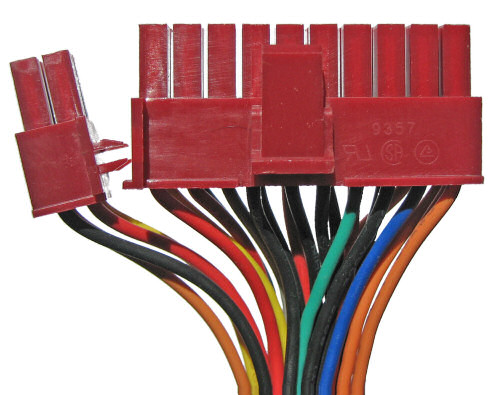
Image showing how to change a power supply’s 24-pin motherboard connector into a 20-pin connector by unclipping the end four-pin blockWhat do the PSU safety protection abbreviations mean?
There are many possible safety protections a PSU can have. Below is a list of what each abbreviation means. Please note, not all PSUs have all safety protections.
- OCP - Over-Current Protection
- OVP - Over Voltage Protection
- UVP - Under Voltage Protection
- SCP - Short Circuit Protection
- OPP - Over Power Protection
- OTP - Over Temperature Protection
- UL - Underwriters Laboratories, more information.
- TÜV - Technical Inspection Association, more information.
- CE - European Conformity, more information.
- FCC - Federal Communications Commission, more information.
- RoHS - Restriction of Hazardous Substances Directive, more information.
- WEE - Electronic waste, more information.
- 80 PLUS - Promotes energy efficiency for PC power supplies, more information.
- ErP - Energy Related Products, more information.
More information on certification marks can be found here.
Top Quiet Power Supplies

Seasonic PRIME Fanless 700W 80PLUS Titanium Modular Power Supply

Seasonic PRIME Fanless 500W 80PLUS Platinum Modular Power Supply

Streacom ST-ZF240 ZeroFlex 240W Passive PSU

Streacom ST-NANO160 160W nanoPSU and AC/DC adapter block

FSP VITA GM 750W 80PLUS Gold Fully Modular ATX 3.1 PSU
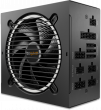
be quiet Pure Power 12 M 750W 80+ Gold Fully Modular ATX3.0 PSU
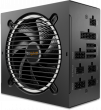
be quiet Pure Power 12 M 1000W 80+ Gold Fully Modular ATX3.0 PSU

Streacom ST-NANO120 120W nanoPSU and AC/DC adapter block

FSP Dagger Pro 850W SFX ATX3.0 Semi-Fanless Modular PSU
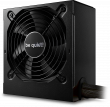
be quiet System Power 10 450W 80Plus Bronze PSU

